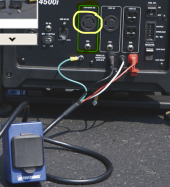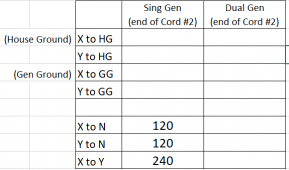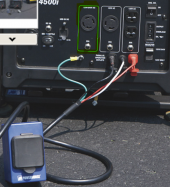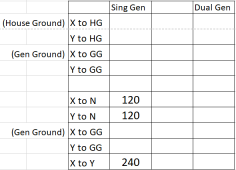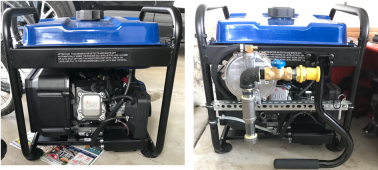ePowerBank
New Member
- Joined
- Apr 13, 2021
- Messages
- 133
I feel all alone on this one having a very unusual generator plug basically without neutral.
Apparently this company designed in something not on any of today's generators - a NEMA 10-50 (on the parallel outlet box).
As I understand, this should be 2 hots and a ground. If that's the case, is there supposed to be a Neutral connection to the generator(s)?
These are 2 new generators for backup power that will be connected to main panel via an interlock, where ground & neutral are bonded.
I get polarity between parallel ground lead and parallel center plug - suggesting the NEMA 10-50 outlet has ground and not common.
I get no polarity between parallel kit's white lead and any of holes on parallel outlet box (?).
I get no polarity between generator control panel's ground & neutral plugs - suggesting it's floating neutral setup.
I thought this is basic stuff, however, when I double generators other day I SMOKED 2 power strips!
Subsequently I bypassed cord #1 (below) and the outlet box and instead connected cord #2 directly into one of the gensets "while" joining the two gensets via the parallel cables - passed initial test (HVAC & Micro etc). Problem is there's only 30A plug directly from geni control panel instead of the 50A on the parallel box, although I'm using a 50A homemade cord.
Thinking this through causes me to think - how can AC return to it's source if Neutral isn't connected?

Apparently this company designed in something not on any of today's generators - a NEMA 10-50 (on the parallel outlet box).
As I understand, this should be 2 hots and a ground. If that's the case, is there supposed to be a Neutral connection to the generator(s)?
These are 2 new generators for backup power that will be connected to main panel via an interlock, where ground & neutral are bonded.
I get polarity between parallel ground lead and parallel center plug - suggesting the NEMA 10-50 outlet has ground and not common.
I get no polarity between parallel kit's white lead and any of holes on parallel outlet box (?).
I get no polarity between generator control panel's ground & neutral plugs - suggesting it's floating neutral setup.
I thought this is basic stuff, however, when I double generators other day I SMOKED 2 power strips!
Subsequently I bypassed cord #1 (below) and the outlet box and instead connected cord #2 directly into one of the gensets "while" joining the two gensets via the parallel cables - passed initial test (HVAC & Micro etc). Problem is there's only 30A plug directly from geni control panel instead of the 50A on the parallel box, although I'm using a 50A homemade cord.
Thinking this through causes me to think - how can AC return to it's source if Neutral isn't connected?





